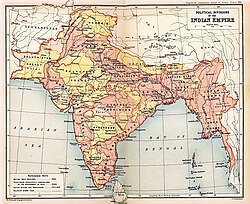India |
|---|
|
|
 |
| Status | Imperial political structure (comprising British India, a quasi-federation of presidencies and provinces directly governed by the British Crown through the Viceroy and Governor-General of India, Princely States, governed by Indian rulers, under the suzerainty of The British Crown exercised through the Viceroy of India)[1] |
|---|
| Capital | Calcutta
(1858–1911)
New Delhi
(1911–1947)
Simla (summer capital)
(1864–1947) |
|---|
| Common languages | |
|---|
| Religion | Hinduism, Islam, Christianity, Sikhism, Buddhism, Jainism, Zoroastrianism, Judaism |
|---|
| Government | British Colonial Government |
|---|
| King-Emperor/Queen-Empress | |
|---|
|
• 1858–1901 | Victoria |
|---|
• 1901–1910 | Edward VII |
|---|
• 1910–1936 | George V |
|---|
• 1936 | Edward VIII |
|---|
• 1936–1947 | George VI |
|---|
|
|
| Viceroy | |
|---|
|
• 1858–1862 (first) | Charles Canning |
|---|
• 1947 (last) | Louis Mountbatten |
|---|
|
|
| Secretary of State | |
|---|
|
• 1858–1859 (first) | Edward Stanley |
|---|
• 1947 (last) | William Hare |
|---|
|
|
| Legislature | Imperial Legislative Council |
|---|
| History | |
|---|
|
| 23 June 1757 and 10 May 1857 |
|---|
| 2 August 1858 |
|---|
| 18 July 1947 |
|---|
| 14 and 15 August 1947 |
|---|
|
|
| Currency | Indian rupee |
|---|
|
|
|